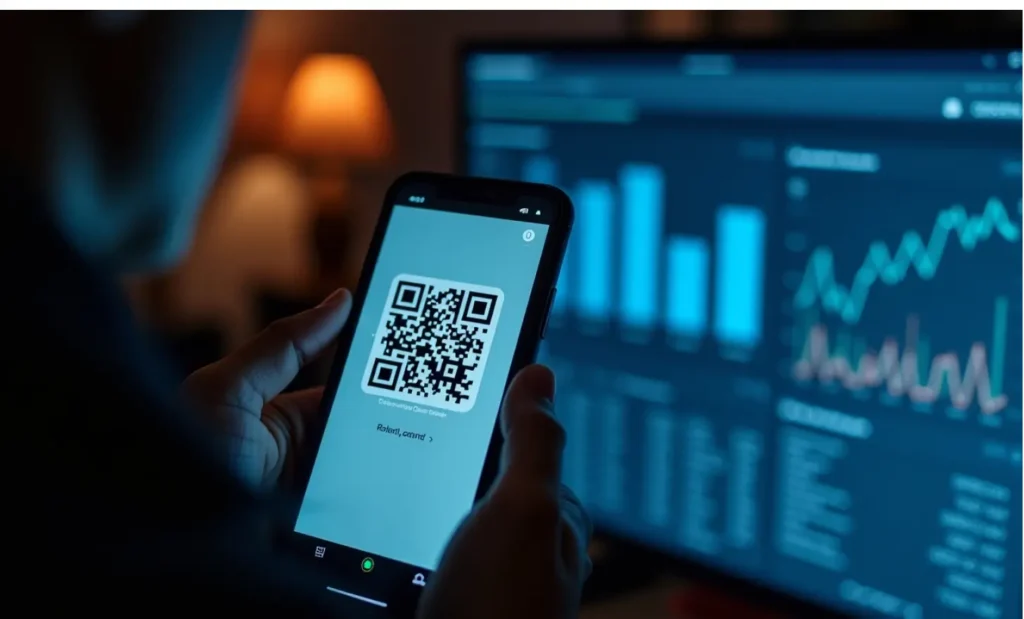Want to track exactly where your website traffic is coming from—even from a poster on a bus stop or a brochure at an event? That’s where a UTM QR code comes in.
By combining the scannability of a dynamic QR code with the precision of UTM parameters, you get powerful insights into how people engage with your offline campaigns. With the right setup, every scan becomes a data point in your analytics tool, helping you optimize your strategy and measure real results.
Let’s break down how it works—and how you can start using it today.
What is a UTM QR code and how does it work?
A UTM QR code is a trackable code that embeds UTM parameters into a link. When someone scans the code, those UTM tags send detailed tracking data to Google Analytics—like where the visitor came from, what campaign they interacted with, and how they ended up on your site.
📌 Quick example:
Instead of just linking to” https://yourwebsite.com” you can use a URL like
“https://yourwebsite.com?utm_source=flyer&utm_medium=qr&utm_campaign=spring_sale”
This version tells your analytics exactly which campaign source generated the visit.
These codes are ideal for bridging the gap between physical and digital marketing. They help you understand what’s actually working—whether it’s a QR code on packaging, business cards, or event materials. You could even add them to NFC tags.

Why use UTM QR codes to track traffic?
If you’re putting QR codes out into the world—on flyers, billboards, packaging, or anywhere else—you want to know if they’re actually driving results. A UTM QR code gives you that clarity.
When paired with an analytics tool like Google Analytics, these codes don’t just tell you how many people scanned—they tell you who scanned, where, and why. That’s a huge upgrade from a standard QR code.
Here’s why marketers rely on UTM QR codes to track traffic and measure success:
📈 Fine-tuned campaign performance
You can break down visits by campaign, source, and medium—so you know whether that poster at the train station outperformed your mailer or event badge.
🧠 Smarter decision-making with real data
No more guessing. You get actionable insights that help you adjust messaging, design, or placement on the fly.
🌍 Offline meets online
Print marketing shouldn’t live in a silo. These trackable QR codes bring your offline audience into your digital funnel, with measurable results.
How to prepare a UTM link before generating a QR code
To create a trackable QR code, the most important step happens before you even generate the code: building a proper URL with UTM parameters.
These utm tags—like utm_source, utm_medium, and utm_campaign—tell your analytics tool exactly where traffic is coming from. Once the link is ready, you can use our QR code generator to turn it into a scannable QR code.
🛠️ Step-by-step: add UTM parameters to your link
- Start with your landing page URL
Example:
https://yourwebsite.com/spring-sale - Add UTM parameters to track traffic sources
Example:
https://yourwebsite.com/spring-sale?utm_source=poster&utm_medium=qr&utm_campaign=spring_sale - Leverage our link shortener
Long URLs with multiple parameters can make QR codes denser. We replace your long link with a shortened URL that improves scan performance and aesthetics. - Create the code with our QR code generator
Once you’ve built your UTM-enhanced URL, generate your code as usual. Every scan will now send valuable data to your analytics.
🧠 Think of your UTM parameters as labels: they tell your analytics platform what the click came from, how it happened, and why it matters.
Best practices to manage parameters and track campaign performance
When you’re working with UTM QR codes, getting the structure of your links right is only half the battle. The real power comes from consistency—because sloppy parameters lead to messy data, and messy data leads to bad decisions.
Here’s how to keep your tracking clean, accurate, and useful:
🏷️ Use clear, consistent parameter names
Stick to lowercase, avoid spaces or special characters, and be specific. For example, use utm_source=flyer instead of utm_source=PrintAd1. Consistency across campaigns ensures your analytics tool can group and compare results correctly.
🎯 Align UTM values with your marketing strategy
Treat your UTM parameters like part of your campaign planning—not just a technical step. Set up naming conventions in advance and document them in a shared dropdown menu or spreadsheet for your team.
🎨 Design your QR codes for performance
A well-designed QR code doesn’t just look good—it gets scanned. Use colors, calls to action, or branding elements to draw attention. And keep the short URL clean to avoid dense, hard-to-read codes.
📊 Monitor your campaign data regularly
Once your QR codes are live, make it a habit to check performance in tools like Google Analytics. Look for traffic under “Traffic acquisition” and sort by campaign source, medium, or landing page.
🔍 If something looks off—like a drop in scans or no data at all—it might be due to a missing tag or misformatted URL. Always double-check before you launch.
By following these practices, you ensure that your QR code tracking gives you real, usable insights—not just noise.
Avoid these common UTM QR code mistakes
Even small mistakes in your UTM QR codes can lead to broken links, lost data, or misleading results in your analytics tool. The good news? They’re all avoidable.
Here are the most common pitfalls—and how to dodge them:
❌ Forgetting to customize UTM parameters
Using the same default tags over and over (like utm_source=campaign) won’t tell you much. Make sure every campaign has clear, specific labels that match your tracking goals.
❌ Using long, messy URLs
A URL packed with tracking parameters can make your QR code bulky and harder to scan. That’s why we clean it up for you with a shortened URL—your users (and your design team) will be happy.
❌ Not testing the QR code before launch
Always scan your QR code and check that it redirects properly and tracks correctly in Google Analytics. A broken link in print is a lost opportunity.
❌ Mixing up naming conventions
If one campaign uses utm_medium=flyer and another says utm_medium=Flyer_2024, your reports won’t group them together. Stick to consistent parameter naming from day one.
❌ Skipping the analytics follow-up
Publishing the code is just the start. If you don’t check your performance data, you’re flying blind. Make a habit of reviewing key metrics like session source, campaign, and website traffic at regular intervals.
🧭 Remember: a UTM QR code is only as useful as the data it gives you. Treat it like a strategic tool—not just a link.

UTM QR codes for offline campaigns and beyond
Most website traffic comes from digital channels—but a surprising amount can start offline. Posters, packaging, brochures, in-store signage… they all have the potential to drive visits. The challenge is tracking them.
That’s where UTM QR codes shine.
By adding UTM parameters to the links behind your printed QR codes, you can track exactly how people from the physical world are reaching your landing page. It’s a simple upgrade that turns anonymous offline engagement into measurable user acquisition.
🧾 Real-world examples:
- A restaurant flyer with a QR code to a reservation page: utm_source=flyer&utm_medium=qr&utm_campaign=spring_menu
- A trade show booth poster sending users to a product demo: utm_source=event&utm_medium=qr&utm_campaign=expo2025
- A product label linking to a video or warranty form
🆚 What about NFC tags?
While NFC tags can also direct users to a link, they typically require newer phones or additional setup. A QR code, on the other hand, works instantly across all smartphone cameras—no app or tap required.
💡 Whether you’re running a local promotion or launching a nationwide print campaign, trackable QR codes help bridge the gap between your offline materials and your online strategy.

Security, privacy, and quality standards you can trust
When you’re tracking user data—even just campaign source or traffic behavior—security and compliance matter.
QR Code KIT is built on a foundation of trust, backed by internationally recognized standards:
- ISO/IEC 27001 for information security management
- ISO 9001 for quality management systems
- ISO 14001 for environmental responsibility
- IEC 18004:2024, the global QR code standard
- And of course, full GDPR compliance to protect user privacy in line with EU regulations
🔐 Whether you’re running a small local campaign or working at scale with sensitive data, you can count on QR Code KIT to keep your information safe, your campaigns compliant, and your reputation protected.

Conclusion: Start tracking with UTM QR codes now
If you’re already using QR codes in your marketing, adding UTM parameters is a small change with a big payoff. It turns every scan into a data point—one you can track, analyze, and use to fine-tune your strategy.
Whether you’re promoting a local event or launching a nationwide campaign, a UTM QR code gives you the insight to understand what’s working and where to double down.
So don’t just guess where your traffic is coming from—track it.
Start building smarter campaigns with UTM-enhanced QR codes and make every scan count.
